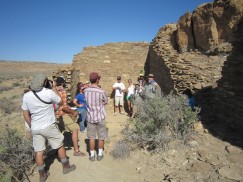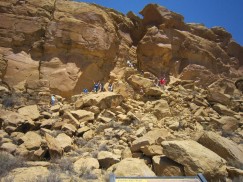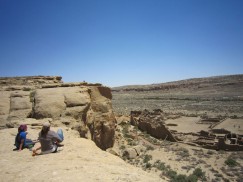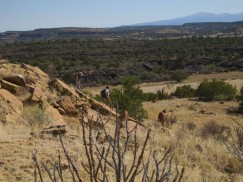- Home
- >
- Preservation Archaeology Blog
- >
- Student Post: Chaco Canyon Field Trip

Early on a Friday morning, the students of the Mule Creek Field School dragged themselves from their tents and piled into the Suburban and the fifteen-passenger van. After an eventful drive in very close quarters—a trip that was supposed to take seven hours, but ended up taking ten due to a tire blowing out on the road—we finally arrived at our destination: Chaco Canyon. We unloaded and set up camp, feasting on a delicious supper of posole made by Rob Jones. We spent the first night of our trip sleeping under the stars on the canyon floor, which was a truly magnificent experience.
The next morning, we got up early to meet up with Paul Reed, who would be giving us a tour of the canyon. We started off with the ruins of Hungo Pavi, Chetro Ketl, and Kin Kletso, all of which were amazing to see. Afterward, we visited Pueblo Bonito, the largest of the Chaco ruins. We roamed through the site, exploring the kivas, the enormous courtyard, and the labyrinth of rooms. It was easy to be overwhelmed by the sheer size of it, and seeing the mostly intact rooms gave us a hint as to what our site may have looked like. It was like peeking through a window into the past.

We ate lunch in the shade of a nearby pavilion, then set out on the trail to the top of the mesa. The climb was trickier for some, especially those of us who are nervous about heights, but we made it through and reached the top. Once there, we followed the trail around the edge of the mesa until we could see Pueblo Bonito sprawling below us. No words can describe it, so here’s a picture.

After our descent, we visited Casa Rinconada, and then set off for the next portion of the trip. We spent the night at a KOA camp in Grants, and were ecstatic to take an indoor shower—something we had been looking forward to for weeks. The next morning we had a brief breakfast and set out for El Malpais National Monument. We hiked through the park to a few sites, including a kiva, a room block, and what may have been a shrine, and then we headed to a rock formation with a fantastic view of the lava flow.

For the last part of our trip, we visited Acoma, the longest continuously inhabited Pueblo settlement in existence. We spent some time in the visitor’s center, then headed up to the top of the mesa, this time by bus. Our tour guide showed us around and explained the history of the settlement, and allowed us time to buy works from the local artists. We were then given the option of riding back to the visitor’s center by bus or by climbing down the old stone stairway. Most of us took the second option.
We then piled back into the van and headed back to Mule Creek. We arrived at the camp exhausted, but happy to be back.
— Kelsey Shaw, Grand Valley State
Explore the News
Related to This
-
Project Las Ventanas